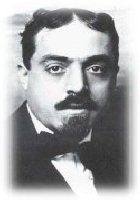- Carlo Carrà
Infobox Person

image_size=150px
name=Carlo Carrà
caption=
birth_date=1881
birth_place=Quargnento ,Italy
death_date=1966
death_place=Milan ,Italy Carlo Carrà (
February 11 1881 —April 13 1966 ) was an Italian painter, a leading figure of the Futurist movement that flourished in Italy during the beginning of the 20th century. In addition to his many paintings, he wrote a number of books concerning art. He was long a teacher in the city ofMilan .Biography
Carrà was born in
Quargnento , nearAlessandria (Piedmont ). At the age of 12 he left home in order to work as a mural decorator.In 1899-1900, Carrà was in
Paris decorating pavilions at the Exposition Universelle, where he became acquainted with contemporary French art. He then spent a few months in London in contact with exiled Italian anarchists, and returned to Milan in 1901. In 1906, he enrolled atBrera Academy ("Accademia di Brera") in the city, and studied underCesare Tallone . In 1910 he signed, along withUmberto Boccioni ,Luigi Russolo andFilippo Tommaso Marinetti the "Manifesto of Futurist Painters", and began a phase of painting that became his most popular and influential.Carrà's Futurist phase ended around the timeWorld War I began. His work, while still using some Futurist concepts, began to deal more clearly with form and stillness, rather than motion and feeling. Carrà soon began creatingstill life s in a style he, along withGiorgio de Chirico , called "metaphysical painting ". Throughout the 1920s and 1930s, the metaphysical phase gave way to a sombre style akin toMasaccio 's. An example from this period is his 1928 "Morning by the Sea".He is best known for his 1911 futurist work, "
The Funeral of the Anarchist Galli ". Carrà was indeed an anarchist as a young man but, along with many other Futurists, later held morereactionary political views, becoming ultra-nationalist and irredentist before and during the war, as well as by Fascism after 1918 (in the 1930s, Carrà signed a manifesto in which called for support of the state ideology through art). [Pinkus, p.20] The "Strapaese" group he joined, founded byGiorgio Morandi , was strongly influenced by fascism and responded to the neo-classical guidelines which had been set by the regime after 1937 [Antliff, p.2; Pugliese, p.16] (but was opposed to the ideological drive towards strong centralism). [Antliff, p.2] He died in Milan.elected works
*"
The Funeral of the Anarchist Galli "(1911)
*"The Enchanted Chamber " (1917)
*"The Metaphysical Muse "(1917)
*"The Daughter of the West " (1919)
*"The Engineer's Lover "(1921)References
* [http://www.guggenheim-venice.it/english/06_artists/carra.htm Carrà at the Peggy Guggenheim Collection]
* [http://findarticles.com/p/articles/mi_m0422/is_1_84/ai_84721212/pg_1 Mark Antliff, "Fascism, Modernism, and Modernity", in "The Art Bulletin", March 2002]
*Karen Pinkus, "Bodily Regimes: Advertising under Italian Fascism",Minneapolis -Saint Paul,University of Minnesota Press , 1995 ISBN 0816625638
*Stanislao G. Pugliese, "Italian Fascism and Anti-Fascism: A Critical Anthology",Manchester ,Manchester University Press , 2001 ISBN 071905639XNotes
External links
* [http://www.tendreams.org/carra.htm Ten Dreams Galleries]
Wikimedia Foundation. 2010.
